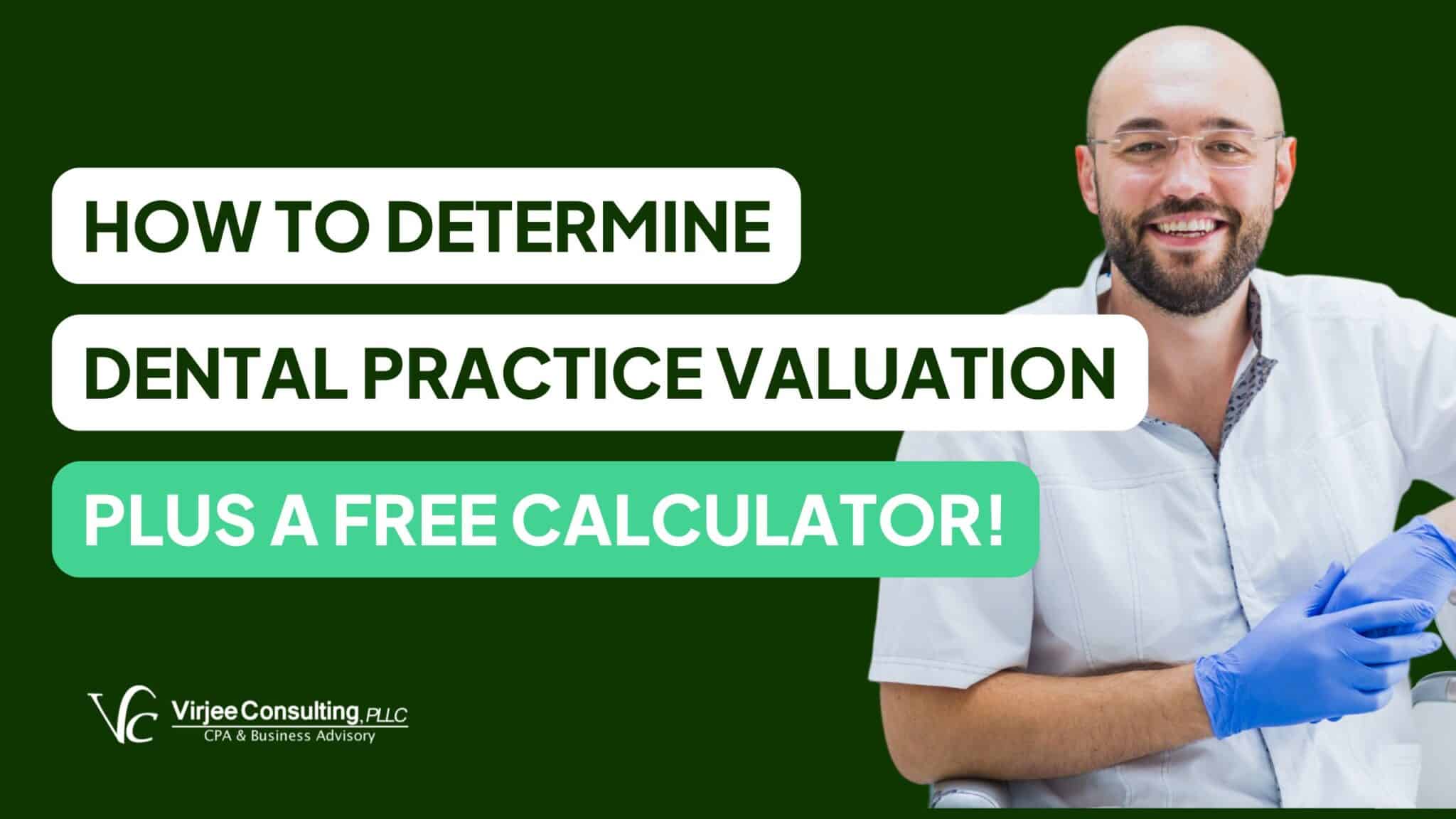Determining your dental practice valuation isn’t a one-size-fits-all process—there are a million ways to go about it, and no single method will give you the full picture.
For instance, the Discounted Cash Flow (DCF) method focuses on your future potential earnings, while the Capitalized Earnings method looks at your past performance. Meanwhile, approaches like the Market-Based Valuation rely on comparisons to other practices, and methods like Net Asset Valuation zero in on your tangible assets.
In this blog, we’ll walk you through five of the most popular ways to value a dental practice.
But keep in mind, the best approach often combines multiple methods for a more complete picture. That’s why working with an experienced dental accountant is your smartest move—they’ll help you pull together the right numbers and ensure nothing gets overlooked, so you get an accurate, well-rounded valuation.
If you want to get a quick idea of what your practice is worth, feel free to skip ahead and try our Free Dental Valuation Calculator. It’s an easy way to start!
5 Dental Practice Valuation Methods To Consider
1. Discounted Cash Flow (DCF) Method
This is one of the most popular ways to value a dental practice because it looks at how much money your practice is expected to make in the future. Here’s how it works:
- Future cash flows: Estimate how much cash your practice will generate over the next 5 to 10 years.
- Present value: Calculate what that future cash is worth today, since money has more value now than in the future.
- Final step: Add up all the discounted cash flows, and you have the estimated value of your practice.
One of the main benefits of the DCF method is that it looks at your business’s future potential, not just past performance.
This is particularly helpful if your dental practice is growing or expanding, as it gives a clearer view of its potential worth down the road. It’s also a highly regarded method among investors and financial experts due to its detail and forward-looking nature.
However, the DCF method has its downsides. It can be tricky because it involves complicated calculations and requires you to make detailed predictions about your future finances, which can be hard if you’re not used to working with numbers like that.
Also, the final value depends on assumptions, like how fast your business will grow and how much it will cost to borrow money. If those guesses are wrong, the result might not be accurate.
2. Capitalized Earnings Method
The Capitalized Earnings Method is a widely used dental practice valuation technique that focuses on historical financial performance, rather than the future. This method looks at how much money your practice has made in the past year or over several years and uses that to calculate its current value.
- How it works: Take your practice’s net income and divide it by an industry-standard rate (usually around 25% to 31% for dental practices) to get the value.
This is great for practices with a steady, predictable income over time. However, since it relies on historical earnings, it doesn’t factor in future potential.
Additionally, practices with highly volatile income or those in a transition period may not get an accurate valuation from this method alone.
3. Market-Based Valuation
The Market-Based Valuation method compares your dental practice to other practices that have recently sold in your area. This approach typically uses a percentage of your practice’s collections, usually between 60% to 80%, to estimate the value of your practice.
- How it works: Let’s say your practice collects $1 million annually. Using a market-based valuation method, and applying a collection multiplier of 70%, your practice would be valued at around $700,000. The goal is to align your practice’s valuation with comparable practices that have been sold in your local market.
While this dental practice valuation method gives you a quick estimate, it doesn’t give the full picture on its own. It doesn’t take into account your practice’s actual profits, and it can be hard to find accurate comparisons. That’s why it’s better to use this method alongside others to get a more complete understanding of your practice’s value.
However, checking out recent sales in your area is still an easy way to see how your practice might compare to others nearby.
4. Net Asset Valuation
The Net Asset Valuation method focuses on calculating the value of the physical and intangible assets your dental practice owns. This includes everything from dental chairs and equipment to intangible assets such as your practice’s reputation, patient base, and goodwill.
Here’s a more detailed explanation of how it works:
- Physical Assets: This part of the valuation looks at the tangible assets in your practice, such as dental chairs, X-ray machines, office furniture, computers, and any real estate the practice owns. The value of these assets is based on their current market value or what you could sell them for today. However, if the equipment is old or outdated, its value may be lower, which could affect the overall valuation.
- Intangible Assets (Goodwill): This is often the largest portion of a dental practice’s value, including the practice’s reputation, patient base, long-term relationships with patients, and brand recognition. Goodwill can make up 80-85% of the practice’s value, as it reflects the benefits of an established, trusted practice.
Since most of a dental practice’s valuation comes from goodwill rather than equipment, this method might undervalue your practice if much of the physical equipment is older.
While this method can be useful for practices with significant real estate or physical assets, it’s typically best to use it alongside other methods that factor in income and future earnings to get a more accurate assessment of the practice’s total worth.
5. Profit-Based Valuation
Last but not least, one of the most popular dental practice valuation methods (and our personal favorite) is the Profit-Based Valuation method. This method calculates your practice’s value based on its annual profit, factoring in key operational elements like rent, equipment, and the number of operatories (treatment rooms).
It’s a practical way to estimate your practice’s worth using readily available financial data.
Here’s how it works:
- Estimate your annual profit: This is your practice’s profit after you’ve paid yourself a reasonable salary. This gives a clearer picture of how much profit the practice generates.
- Monthly rent: Your operating expenses, such as rent, play a significant role in determining the overall value. Higher fixed costs can affect your practice’s profit margins and, ultimately, its valuation.
- Number of operatories: The number of treatment rooms directly impacts your practice’s revenue potential. More operatories mean the ability to treat more patients, which can increase the overall value of your practice.
- Equipment value: Factor in the current value of your dental equipment, such as chairs, X-rays, and other technology. Equipment that is up-to-date or in good condition adds to the practice’s worth.
As experienced dental CPAs, we’ve handled numerous dental practice valuations and frequently recommend this method because it combines profitability and growth capacity to provide a well-rounded estimate.
It’s a straightforward approach that gives you a realistic sense of your practice’s worth, especially when other data might not be as readily available.
Want to Make Your Dental Practice Valuation Even Easier?
If all of this sounds a bit complex and overwhelming, don’t worry!
We’ve made it easy to quickly estimate your practice’s value with our Free Dental Valuation Calculator.
It’s a fast and simple tool to help you understand what your practice might be worth today.
Need More Help With Your Dental Practice Valuation?
Whether you’re thinking about buying or selling a dental practice—or just curious about what yours might be worth—knowing how to calculate a dental practice valuation is a valuable skill.
At Virjee Consulting, we specialize in helping dentists navigate every step of the exit journey. Our free calculator is a great starting point, but if you want a deeper, more comprehensive valuation, we can take it from there and factor in all the details.
If you’re interested in learning more about how we can help, head over to our Contact page to get started. We’re here to help!
And in the meantime, don’t forget to check out our free calculator for a quick and simple dental practice valuation in seconds.
Until next time!

